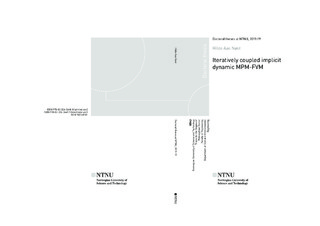| dc.description.abstract | Several geotechnical engineering problems involve the interaction between deformation of the soil skeleton and the development of pore water pressures. Very often the deformations are considered to be small, which opens for a classical Lagrangian finite element analysis. However, large deformations are present in several geotechnical problems. Large deformations with methods such as updated Lagrangian finite element method might lead to severe mesh distortion. The material point method (MPM) is a method that avoids severe mesh distortion and can model large deformation problems with coupled flow. In literature, all approaches for coupling flow and mechanics with MPM use explicit time integration.
This thesis aims to develop a two-way coupled flow MPM with implicit time integration applicable to large deformation problems of flow through saturated porous media. Implicit time integration allows larger time steps and fewer computation steps for long-running processes. Minor aims are extending single-phase MPM software with the proposed method and an explicit approach from literature, and assessing the performance of the explicit and implicit approaches.
The explicit formulation uses the phase velocities as primary variables. The proposed implicit formulation uses the pore pressures and the displacements as primary variables. Additionally, the proposed formulation uses an iteratively coupled approach that splits the system into a mechanical part and a flow part which can be solved by separate solvers. This work couples MPM with the finite volume method (FVM) by taking advantage of the similarities between the finite element method (FEM) and MPM.
Both the explicit and implicit methods solves the one-dimensional consolidation problem. The quasi-static implicit approach has no oscillations at the beginning of the simulation. The dynamic implicit approach and the explicit approach experiences oscillations, with the explicit much larger than the implicit. Implicit time steps are 102 to 103 times larger than the explicit time steps. The implicit method simulates large deflection of a poroelastic beam. The bending moment generates suction and pressure in the upper and lower parts of the beam, respectively. The beam deflects further while the pore pressures dissipate.
The proposed method can model both large deformations and coupled flow. The implicit time integration makes the method suitable for solving slow to medium rate coupled flow problems. Additionally, due to the modular nature of the proposed method, it is suited for extending single-phase implicit MPM codes to include coupled effects. Further work includes using advanced material models and extending the proposed method to model unsaturated soils. | nb_NO |
